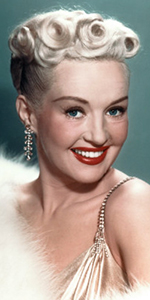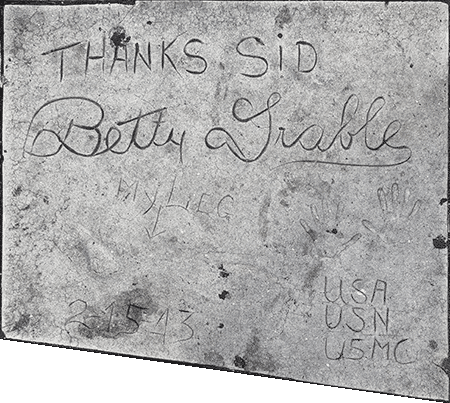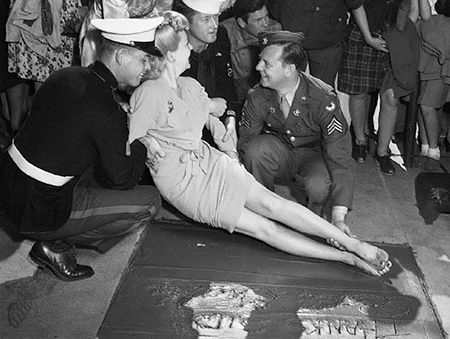 |
 |
 |
 |
 |
| Betty Grable; unknown date. |
| |
|
 |
|
 |
| |
| |
|
|
| Betty Grable
|
 |
| Forecourt Ceremony held on Monday, February 15, 1943 |
| |
Born: Elizabeth Ruth Grable, December 18, 1916, in St. Louis, Missouri
Age at the time of the ceremony: 26
Died: July 2, 1973, in Los Angeles, California, age 56 |
| |
Betty Grable transcended mere movie stardom to join a small group of Hollywood "sex symbols." Excelling in her musical pictures for the Fox studio, she became an icon of the World War II era with her famous pin-up photos, which were adored by the troops fighting the war. It was only fitting that representatives of three branches of the services placed Grable and her leg in the cement at Grauman's.
Born to Dutch-English, German-Irish parents, young Betty had a "stage mother" named Lillian, who relentlessly pushed her youngest daughter into performing. After winning local beauty contests, they both made the move to Hollywood, with Lillian lying about Betty's age, getting her a role in Happy Days (released in February 1930) at Fox. She was 12.
At age 13, Grable became one of the original Goldwyn Girls, appearing in Eddie Cantor's hit film Whoopie! (released in October 1930). Grable signed a contract with the R-K-O studio, and made her first film there at age 14 in Probation (released in April 1932). She was loaned out for Cavacade (which played the Chinese in January 1933), and was featured in the Astaire Rogers musicals The Gay Divorcee (released in October 1934), and Follow the Fleet (released in February 1936).
Now under contract to Paramount, Grable returned to the 20th Century-Fox studio to make Pigskin Parade (which played the Chinese in November 1936), then returned to Paramount to appear in a string of pictures were she played college girls: This Way Please (released in October 1937), and College Swing (released in April 1938).
Somewhat miffed at all of this, Grable snagged a role in the Cole Porter musical DuBarry Was a Lady, which premiered on Broadway in December 1939 and ran for 400 performances. Among those who saw Grable in the play was Darryl F. Zanuck, who had Grable screen tested(!), then offered her a long-term contract. She took over for an ailing Alice Faye in the Technicolor musical Down Argentine Way (which played the Chinese in October 1940, with Don Ameche and Carmen Miranda. It was a whopping hit.
Grable was the new player in the Fox musical unit. Next was Tin Pan Alley (which played the Chinese in November 1941), with Alice Faye, and Moon Over Miami (played the Chinese in July 1941) with Don Ameche, but Fox thought Grable might click in non-musicals, like A Yank in the R.A.F. (played in September 1941), and I Wake Up Screaming (aka, Hot Spot - played in November 1941) with Victor Mature.
But Grable was more inclined to play in musicals with lesser-known leading men. And so there was Song of the Islands (which played the Chinese in March 1942) with Victor Mature, Footlight Serenade (played the Chinese in August 1942) again with John Payne, followed by Grable's greatest wartime hit. Springtime in the Rockies (played in October 1942) with John Payne. By now, Grable was America's top box-office draw. Her popularity as a pin-up among the troops fighting in World War II, led to having representatives of the three brances of the service to place Grable's famous leg into the cement during her Forecourt ceremony.
Grable's next picture, Coney Island (which played the Chinese in June 1943), was an even bigger hit. The Technicolor musical Sweet Rosie O'Grady (played the Chinese in September 1943) with Robert Young followed, but when Fox attempted to get Grable to mix things up by having her star in non-musicals again, she baulked. So musicals it was to be: she made Pin-Up Girl (played in May 1944) with John Harvey, Diamond Horseshoe (played in May 1945), with Dick Haymes, and The Dolly Sisters (played in February 1946) with June Haver in such quick succession that she badly needed a vacation with her family.
But the Grable pictures were the ones keeping 20th Century-Fox in the black, so they wanted Grable back to work as soon as possible. The reluctant Grable appeared in The Shocking Miss Pilgrim (which played the Chinese in February 1947) with Dick Haymes, but the film did not do well. This was followed by Mother Wore Tights (played the Chinese in September 1947) with Dan Dailey, which became a mega-hit.
Although started by director Ernst Lubitsch who died during shooting, That Lady in Ermine (which played the Chinese in August 1948) with Douglas Fairbanks, Jr., it was finished by Otto Preminger, with whom Grable clashed. That Lady only did so-so business, but Grable's next, When My Baby Smiles at Me (played the Chinese in November 1948) with Dan Dailey again, was a hit. The oddly misshapen comedy The Beautiful Blonde from Bashful Bend (played in May 1949) with Cesar Romero was an outright flop.
Still, Grable continued to be a box-office draw, so Fox tried to create projects which were more in-line her talents. Wabash Avenue (which played the Chinese in April 1950) re-teamed her with Victor Mature and did well, as did My Blue Heaven (played the Chinese in September 1950), which re-teamed her with Dan Dailey. But Grable continued to have trouble finding projects that she wanted to do.
Dutifully, she made Call Me Mister (which played the Chinese in February 1951) with Dan Dailey, and Meet Me After the Show (played the Chinese in August 1951) with Macdonald Carey, but afterwards, she wanted to re-negotiate her contract. The studio dug in, and Grable went on strike, robbing her of the opportunity to appear in Gentlemen Prefer Blondes (which played the Chinese in July 1953), her role going to Marilyn Monroe. She refused to work on her next Fox project, so the studio put her on suspension.
But somehow, the show must go on. Grable starred in the musical remake of The Farmer Takes a Wife (released in July 1953) with Dale Robertson, which tanked, then co-starred with Marilyn Monroe and Lauren Bacall in How to Marry a Millionaire (released in November 1953), which became a huge hit — the biggest of Grable's career, in fact. To fulfill her contract, she did Three for the Show (released in February 1955) with Marge and Gower Champion, and How to Be Very Very Popular (which played the Chinese in July 1955) which was to have starred Monroe, but Grable co-starred with Sharee North instead. The film got by, and was Grable's final film.
Grable toured onstage in Guys and Dolls, Hello, Dolly!, Born Yesterday and Belle Star into the early 1970s. Grable developed a fatal lung cancer and died in 1973 at the age of 56. |
|
|
|
|
| |
 |
 |
| Grauman's Chinese Theatre, Hollywood, California. Betty Grable Forecourt block. Executed by Jean Klossner, Monday, February 15, 1943. 48 x 43 inches. |
 |
 |
 |
| Grauman's Chinese Theatre, Hollywood, California. Betty Grable Forecourt ceremony, Monday, February 15, 1943. Betty Grable's famous leg is imprinted with the help of B. L. Duckett, USMC, Navy Gunner's Mate Third Class J. O. Buchanan, and Army Sergeant Albert Waas. |
|
|